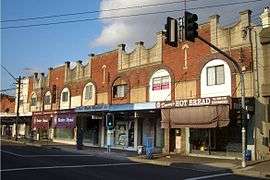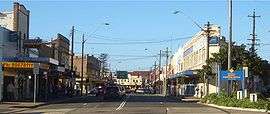Bexley, New South Wales
| Bexley Sydney, New South Wales | |||||||||||||
|---|---|---|---|---|---|---|---|---|---|---|---|---|---|
 Forest Road, Bexley | |||||||||||||
| Coordinates | 33°57′24″S 151°07′34″E / 33.9568°S 151.12621°ECoordinates: 33°57′24″S 151°07′34″E / 33.9568°S 151.12621°E | ||||||||||||
| Population | 19,067 (2011 census)[1] | ||||||||||||
| Established | 1822 | ||||||||||||
| Postcode(s) | 2207 | ||||||||||||
| Location | 14 km (9 mi) south of Sydney CBD | ||||||||||||
| LGA(s) | Bayside Council | ||||||||||||
| State electorate(s) | |||||||||||||
| Federal Division(s) | Barton | ||||||||||||
| |||||||||||||
Bexley is a suburb in southern Sydney, in the state of New South Wales, Australia. Bexley is located 14 kilometres south of the Sydney central business district, in the local government area of the Bayside Council and is part of the St George area.
History
James Chandler named the suburb after his birthplace, Bexley in the south-east of London, England. Chandler bought Sylvester’s Farm in 1822, from Thomas Sylvester who had been granted the land about ten years earlier. That year he was also granted 1,200 acres (490 ha) of land which stretched from what is now Bexley North to most of Rockdale and Kogarah. The estate was heavily timbered and a track through the centre, used by timber-getters, is today called Forest Road. Queen Victoria Street, Gladstone Street and Beaconsfield Street commemorate the British Queen and two of her prime ministers. Chandler was a well-respected citizen and became known locally as the Squire of Bexley, but his property attracted bushrangers, escaped convicts and other odd types. Chandler was not happy with his ill-assortment of neighbours and sold the land to Charles Thompson in 1836. Later it was bought by Charles Tindell, who began subdividing the land by 1856 for home sites.[2]

Lydham Hall, the oldest surviving residence in the area, stands on part of the original land grant of 1822. Joseph Davis settled in this historic residence in the late nineteenth century. Herbert and Frederick Streets are named after his two sons. Henry Kinsela lived on Kinsel Grove. George Preddy occupied Besborough, part of which became Bexley Park.[3]
Dick Stone sold meats in Bexley and Rockdale from 1868. Stone’s Slaughterhouse in Stoney Creek Road began operations in the 1890s. Cattle, sheep and pigs were driven from Homebush to the abattoirs in Kingsgrove until they closed in 1920.[3]
An upsurge in development began after the railway line to Hurstville was opened in 1884. A two-tier wagonette and hansom cab conveyed train travellers to their homes and in 1909 a steam tram ran between Bexley and Arncliffe. Many inns opened in the area including the Man of Kent, the Robin Hood and Little John Inn and the Highbury Barn. In 1900, Hurstville Council ceded its Bexley ward which became Bexley council. Bexley Council was merged with Rockdale Council in 1948 to form the Municipality of Rockdale.[4]
In the 1980s and 1990s, Bexley underwent serious decline since its main street, Forest Road, was on the major truck route between Port Botany and the start of the M5 Motorway at Beverly Hills. This changed in the late 1990s with the completion of the M5 East Motorway and the subsequent bypass of most heavy and commuter traffic from the main street. The opening of Westfield Hurstville in 1979 also contributed to the decline of the Bexley shopping strip.
Commercial area

Bexley contains a mixture of residential, commercial and light industrial developments. Bexley's main shopping strip (usually known as the 'Bexley Shopping Centre') is located on Forest Road. It includes a busy intersection with Bexley Road and Harrow Road (characterised by the art deco former Commonwealth Bank building), and another busy intersection at Stoney Creek Road (characterised by the Forest Inn Hotel). Before a downturn in the 1980s, the shopping centre included several banks, building societies and many grocery and specialty shops. Many of the banks have found new uses, such as office space in the former Commonwealth Bank, and an IGA supermarket for the former site of a Coles Variety Store. Many of the current shops are of speciality styles.

Commercial developments extend some distance down Stoney Creek Road towards Kingsgrove and are also scattered along Forest Road, south towards Hurstville and north towards Arncliffe. The area heading towards Hurstville (at the intersection of Willison Road) is usually referred to Bexley South. It contains a post office, two pizza chains and a variety of smaller specialty shops.
The light industrial developments are located on Forest Road between Bexley and Hurstville, but are slowly being replaced by medium-density residential.
There are also a small number of commercial developments on Queen Victoria Street towards Kogarah.
Transport
Bexley is currently served by State Transit Authority government buses, Transdev NSW and Punchbowl Bus Company private buses. A steam tramway opened on 13 October 1909 and operated from Arncliffe railway station via Firth and Done Streets and then onto Wollongong, Forest and Stoney Creek Roads to Bexley Park, near Preddys Road. It closed on 1 January 1927.[5]
Population
According to the 2011 census of Population, there were 19,067 people usually resident in Bexley. 52.6% of people were born in Australia. The most common other countries of birth were China (excludes SARs and Taiwan) 6.6%, Lebanon 4.4%, Macedonia 4.1%, Greece 2.8% and New Zealand 2.3%. 39.7% of people only spoke English at home. Other languages spoken at home included Arabic 12.7%, Greek 8.4%, Macedonian 7.1%, Cantonese 5.3% and Mandarin 5.2%. The most common responses for religion in Bexley were Catholic 24.5%, Eastern Orthodox 19.3%, No Religion 12.8%, Islam 12.8% and Anglican 8.1%.[1]
Notable residents
- Bill Currey, VC - war hero and politician
- James Goyen - property developer/builder in the St. George and Sutherland Shire area
- Patricia Carlon - crime fiction/thriller writer [6]
Parks
There are several parks located in Bexley, including Bexley Park, Seaforth Park (which is state heritage listed), Dominey Reserve, Bexley Golf Course, Kingsgrove Park, Evatt Park, Flynn Reserve and Bardwell Creek Reserve, beside Bardwell Creek.
Pop culture
- 'Bexley Stamps' and the 'Barber Shoppe' in Forest Road featured in an episode of television series, Two Twisted. The episode, titled Von Stauffenberg's Stamp, starred Sam Neill and Wendy Hughes.
- On Roy and HG's radio show on Triple J radio, they have created a fake advertisement for 'New Old Melbourne Town' in Bexley.
Gallery
Houses
Bexley possesses an extremely wide range of houses in various architectural styles. The following is a small sample.
-
Two-storey home, Gladstone Street
-
Single-storey Federation cottage with wrought-iron detailing, Gladstone Street
-
Cottage with wrap-around verandahs and wrought-iron detailing, Harrow Road
-
Esperanza, Harrow Road
References
- 1 2 Australian Bureau of Statistics (31 October 2012). "2011 Community Profiles: Bexley (State Suburb)". 2011 Census of Population and Housing. Retrieved 13 October 2013.
- ↑
- The Book of Sydney Suburbs, Compiled by Frances Pollon, Angus & Robertson Publishers, 1990, Published in Australia ISBN 0-207-14495-8, Page 28
- 1 2 Pictorial Memories ST. GEORGE: Rockdale, Kogarah, Hurstville Joan Lawrence, Kingsclear Books, 1996, Published in Australia ISBN 0-908272-45-6, page 30
- ↑ Pictorial Memories ST. GEORGE: Rockdale, Kogarah, Hurstville Joan Lawrence, Kingsclear Books, 1996, Published in Australia ISBN 0-908272-45-6, page 31
- ↑ Pictorial Memories ST. GEORGE: Rockdale, Kogarah, Hurstville Joan Lawrence, Kingsclear Books, 1996, Published in Australia ISBN 0-908272-45-6, page 32
- ↑ Windham, Susan ‘Ace thriller writer trapped in a silent world’ Sydney Morning Herald 25 September 2002.
| Wikimedia Commons has media related to Bexley, New South Wales. |